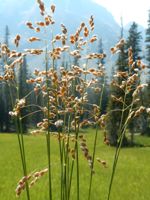Mon-Fri 9am - 5pm Mountain time
Sweetgrass vs Alpine Bluegrass
Anthoxanthum hirtum/Anthoxanthum nitens (Hierochloe odorata))
Poa alpina
CUSTOM GROW
CUSTOM GROW
Sweetgrass is a cool-season perennial grass best known for its sweet, vanilla-like fragrance. The scent comes from coumarin in the leaves, which is pleasant to humans but has a bitter taste that makes the plant less appealing to deer and other herbivores. As a cool-season grass, Sweetgrass grows most vigorously in spring and fall, slowing or even going dormant during the heat of summer.
It spreads quickly through creeping rhizomes and can be difficult to remove once established, so it is best planted in areas where its spread will not cause problems. Due to its deep, vigorous root system and preference for moist soils, Sweetgrass is especially useful for erosion control, soil stabilization, riparian plantings, and naturalization projects.
Note: Sweetgrass was formerly classified under the scientific name Hierochloe odorata and its subspecies. The subspecies found in Canada are currently considered two distinct species: Anthoxanthum hirtum, which is native across Canada, and Anthoxanthum nitens, which is native to Eastern Canada. Because these two species are alike and share many overlapping common names, they are often considered as only one species.
Alpine Bluegrass is a native perennial bunchgrass adapted to cold, high-altitude, and northern environments. It establishes well in harsh mountain and tundra conditions, thriving even in nutrient-poor soils. Its dense tufts provide reliable ground cover in alpine and subalpine habitats.
Hardy and low-maintenance, Alpine Bluegrass is valued in revegetation and erosion control projects due to its strong root system. It provides forage for wildlife and livestock, while its dense growth also offers cover for small animals. Well-suited for reclamation and soil stabilization in high-elevation and northern regions, Alpine Bluegrass is a key species for strengthening fragile landscapes, though it is also found in lower-elevation sites.
Sweetgrass Quick Facts
Alpine Bluegrass Quick Facts
Toxicity: toxic if large amounts ingested

